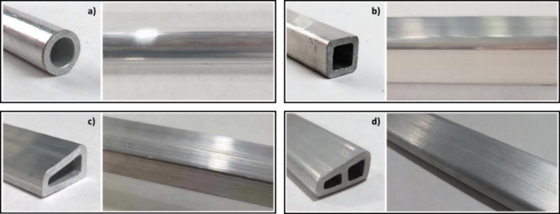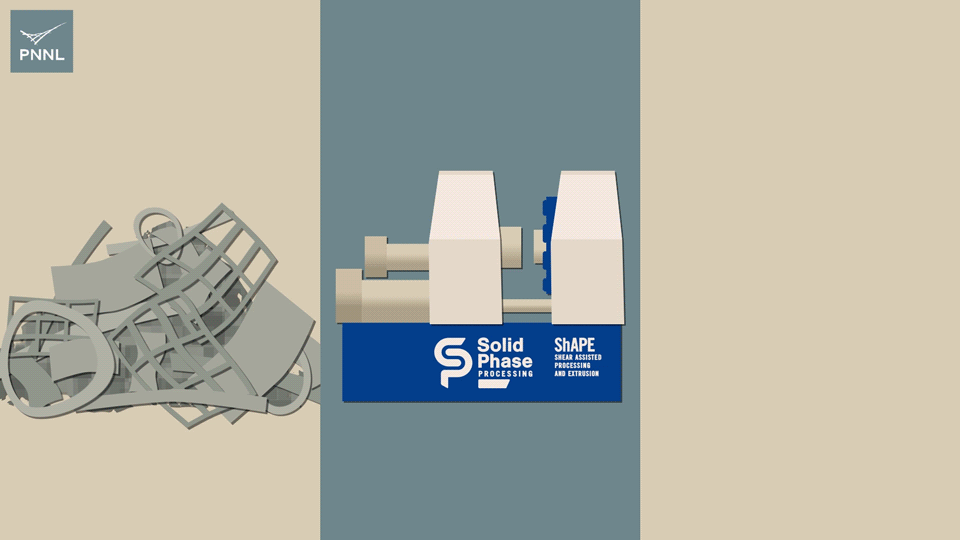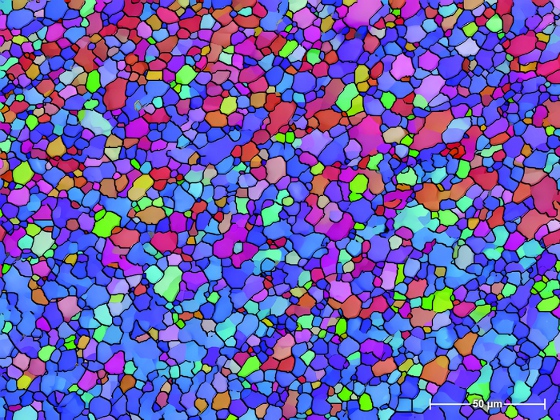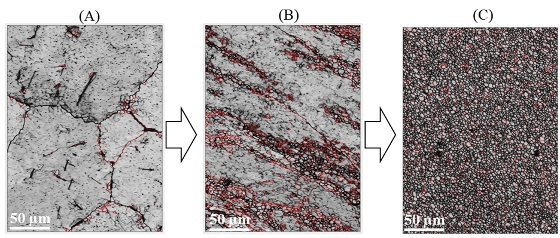 |
| May 23, 2023 | Volume 19 Issue 20 |
Designfax weekly eMagazine
Archives
Partners
Manufacturing Center
Product Spotlight
Modern Applications News
Metalworking Ideas For
Today's Job Shops
Tooling and Production
Strategies for large
metalworking plants
Car parts: Aluminum scrap to high-strength parts in minutes
A new manufacturing process produces high-strength aluminum vehicle parts that lower costs and are more environmentally friendly.
Editor's Note: Good videos at end of article.

Extrusions made from AA6063 industrial scrap using the ShAPE process to produce (a) circular, (b) square, (c) trapezoidal, and (d) two-cell trapezoidal profiles. [Credit: Image courtesy Scott Whalen/Pacific Northwest National Laboratory]
Scrap aluminum can now be collected and transformed directly into new vehicle parts using an innovative process being developed by the automotive industry, in particular for electric vehicles (EVs). Recently, the Department of Energy's Pacific Northwest National Laboratory (PNNL), in collaboration with leading mobility technology company Magna, unveiled a new manufacturing process that reduces more than 50% of the embodied energy and more than 90% of the carbon dioxide emissions by eliminating the need to mine and refine the same amount of raw aluminum ore. Lightweight aluminum can also help extend EV driving range.
This patented and award-winning Shear Assisted Processing and Extrusion (ShAPE™) process collects scrap bits and leftover aluminum trimmings from automotive manufacturing and transforms it directly into suitable material for new vehicle parts. It is now being scaled to make lightweight aluminum parts for EVs.
The most recent advancement, described in detail in a new report and in a Manufacturing Letters research article, eliminates the need to add newly mined aluminum to the material before using it for new parts. By reducing the cost of recycling aluminum, manufacturers may be able to reduce the overall cost of aluminum components, better enabling them to replace steel. [Editor's Note: This new report has some very good details about the machine in it.]
"We showed that aluminum parts formed with the ShAPE process meet automotive industry standards for strength and energy absorption," said Scott Whalen, a PNNL materials scientist and lead researcher. "The key is that ShAPE process breaks up metal impurities in the scrap without requiring an energy-intensive heat treatment step. This alone saves considerable time and introduces new efficiencies."

Animation: Automakers' aluminum scrap transforms into new vehicle parts with the PNNL-patented ShAPE manufacturing process. Heat and friction soften the aluminum and transform it from rough metal into a smooth, strong uniform product without a melting step. [Credit: Animation by Sara Levine/Pacific Northwest National Laboratory]
The new report and research publications mark the culmination of a four-year partnership with Magna, the largest manufacturer of auto parts in North America. Magna received funding for the collaborative research from DOE's Vehicle Technologies Office, Lightweight Materials Consortium (LightMAT) Program.
"Sustainability is at the forefront of everything we do at Magna," said Massimo DiCiano, manager of Materials Science at Magna. "From our manufacturing processes to the materials we use, the ShAPE process is a great proof point of how we're looking to evolve and create new sustainable solutions for our customers."
Aluminum advantages
Besides steel, aluminum is the most used material in the auto industry. The advantageous properties of aluminum make it an attractive automotive component. Lighter and strong, aluminum is a key material in the strategy to make lightweight vehicles for improved efficiency, being it extending the range of an EV or reducing the battery capacity size. While the automotive industry currently does recycle most of its aluminum, it routinely adds newly mined primary aluminum to it before reusing it, to dilute impurities.
Metals manufacturers also rely on a century-old process of pre-heating bricks, or "billets" as they are known in the industry, to temperatures over 1,000°F (550°C) for many hours. The pre-heating step dissolves clusters of impurities such as silicon, magnesium, or iron in the raw metal and distributes them uniformly in the billet through a process known as homogenization.
By contrast, the ShAPE process accomplishes the same homogenization step in less than a second and then transforms the solid aluminum into a finished product in a matter of minutes -- with no pre-heating step required.

The microstructure within an aluminum trapezoid shows highly refined and uniform grain size, key to achieving a strong and reliable product. [Credit: Image courtesy of Nicole Overman; enhancement by Cortland Johnson/Pacific Northwest National Laboratory]
"With our partners at Magna, we have reached a critical milestone in the evolution of the ShAPE process," said Whalen. "We have shown its versatility by creating square, trapezoidal, and multi-cell parts that all meet quality benchmarks for strength and ductility."
For these experiments, the research team worked with an aluminum alloy known as 6063, or architectural aluminum. This alloy is used for a variety of automotive components, such as engine cradles, bumper assemblies, frame rails, and exterior trim. The PNNL research team examined the extruded shapes using scanning electron microscopy and electron backscatter diffraction, which creates an image of the placement and microstructure of each metal particle within the finished product. The results showed that the ShAPE products are uniformly strong and lack manufacturing defects that could cause parts failure. In particular, the products had no signs of the large clusters of metal -- impurities that can cause material deterioration and that have hampered efforts to use secondary recycled aluminum to make new products.
The research team is now examining even higher strength aluminum alloys typically used in battery enclosures for electric vehicles.
"This innovation is only the first step toward creating a circular economy for recycled aluminum in manufacturing," said Whalen. "We are now working on including post-consumer waste streams, which could create a whole new market for secondary aluminum scrap."
The patented ShAPE technology is available for licensing for other applications.
SIDEBAR: A little more about the ShAPE technology and process from PNNL
During ShAPE manufacturing, metals are processed using shear forces to produce high-performance metal alloys for use in vehicles and other applications.
The ShAPE machine eliminates the need for separate homogenization and extrusion steps by combining heating and deformation -- the change in the shape of the metal itself. In the ShAPE machine, the metal billet is simultaneously pushed through a small opening in a die that also rotates. Together, the rotational movement and deformation thoroughly mixes the metal elements as they are being extruded. Essentially, the ShAPE process homogenizes the metal billet in a few seconds, immediately before it is extruded. This eliminates the need for a day-long, pre-heating homogenization step and means that no additional energy is used to heat the billet during extrusion. Together, this results in an energy savings of up to 50% using ShAPE.
Not only is ShAPE a more energy-efficient and quicker process, but it also improves how well the individual alloying elements are mixed, leading to a better final product. Just as lumpy batter can ruin a cake, the final product in extrusion manufacturing often performs better when the elements are well mixed. Performance testing showed that components made of aluminum alloys processed with ShAPE exceeded current American Society for Testing and Materials standards for strength and elongation.

Images of aluminum alloy 7075 taken with a scanning electron microscope before (A), during (B), and after (C) going through the ShAPE machine show how the microstructure of the alloy changes dramatically during extrusion. The shearing effect of the ShAPE machine breaks up particles, which are akin to lumps in cake batter, into much smaller pieces to create a more uniform microstructure. [Credit: Image by Joshua Silverstein/Pacific Northwest National Laboratory]
"We took a closer look using an electron microscope and saw that ShAPE breaks apart the alloy aggregates and dissolves them into the aluminum matrix prior to extrusion, making it more extrudable," said Tianhao Wang, PNNL materials scientist and lead author on a 2021 publication in Materials and Design. "This translates to better performance -- our aluminum 7075 alloys are stronger and stretch farther before breaking."
According to the PNNL ShAPE information web page, "The simultaneous linear and rotational forces use only 10% of the force typically needed to push the material through the die in conventional processes. This significant reduction in force enables substantially smaller production machinery, thus lowering capital expenditures and operations costs. Energy consumption is similarly low. The amount of electricity used to make a 1-ft length of 2-in. diameter tubing is about the same as it takes to run a residential kitchen oven for just 60 seconds."
A 2019 article in Designfax by PNNL described the ShAPE process in more depth using aluminum alloy powders. A video (below) from that article is useful to review for people interested in the technology. In regard to PNNL's latest developments, making the jump from aluminum alloy powders to aluminum scrap used in the process seems like a natural progression with myriad productivity gains.
Interestingly, the ShAPE process can also be used to join dissimilar metals. PNNL demonstrates that process here:
Source: DOE/Pacific Northwest National Laboratory
Published May 2023
Rate this article
View our terms of use and privacy policy
